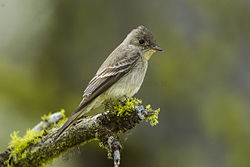| Western wood pewee | |
|---|---|
 | |
| Scientific classification | |
| Kingdom: | Animalia |
| Phylum: | Chordata |
| Class: | Aves |
| Order: | Passeriformes |
| Family: | Tyrannidae |
| Genus: | Contopus |
| Species: | C. sordidulus |
| Binomial name | |
| Contopus sordidulus Sclater, PL, 1859 | |
 | |
Breeding Migration Nonbreeding | |
The western wood pewee (Contopus sordidulus) is a small tyrant flycatcher.
